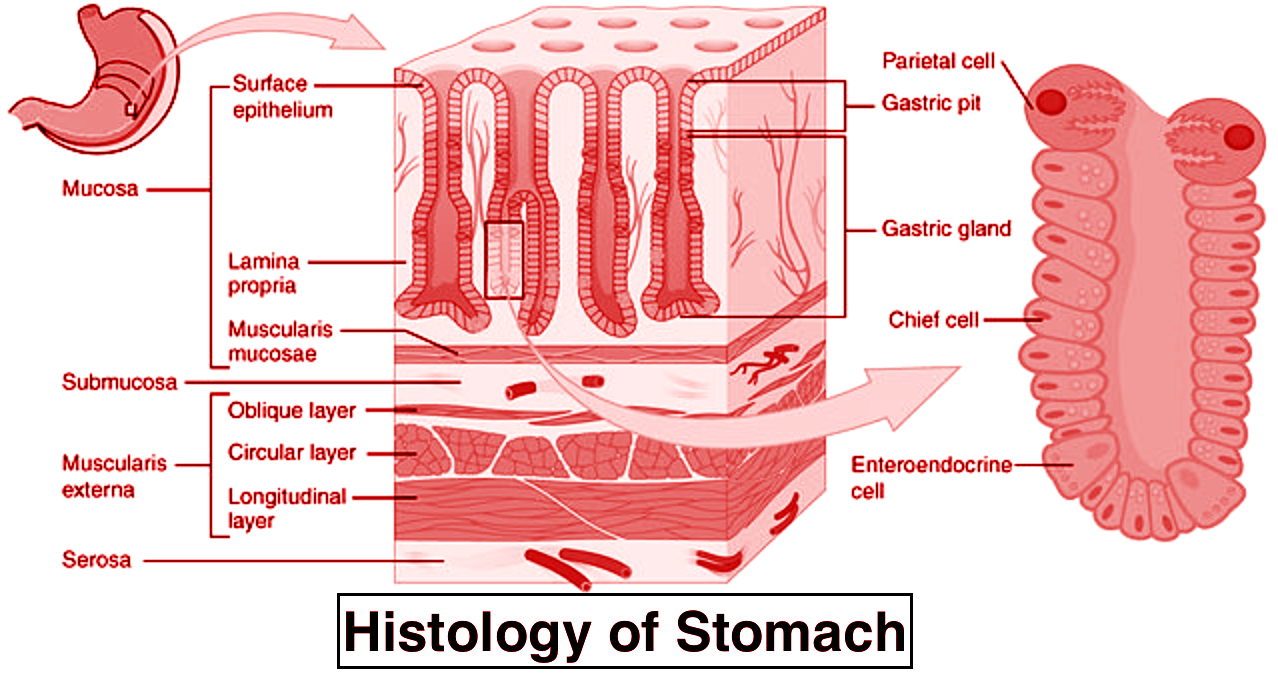
In which layer of the stomach is gastric glands located?
(a) Serosa
(b) Mucosa
(c) Submucosa
(d) Muscularis mucosa
Answer
488.1k+ views
1 likes
Hint: The gastrointestinal wall including the stomach wall consists of 4 different layers namely mucosa, submucosa, muscularis, and serosa. The mucosa is the innermost layer whereas the serosa is the outermost. The stomach wall contains the gastric glands that secrete the HCL as well as pepsinogen and intrinsic factors.
Complete answer:
Gastric glands are located in the innermost mucosa layer. A layer of surface epithelium cells and the underlying lamina propria with muscularis mucosae forms the mucosal layer of the stomach. The gastric glands inside it secrete important gastric juices necessary for the digestion of food.

So, the correct answer is ‘Mucosa’.
Additional Information: The innermost layer of the stomach consists of surface epithelium. This is called the mucosal layer. The epithelium is simple columnar type. The other layers of the stomach are submucosa, muscularis, and serosa. These layers are very important for the stomach to perform its activities. In fact, the whole gastrointestinal tract follows the same histology.
The simple columnar cells act as surface mucous cells and form tiny invaginations in the stomach wall called gastric pits, which connect the different glands and help the delivery of products among them. The epithelial cells also secrete highly viscous alkaline mucus.
Along with gastric glands, the mucosa of the stomach has 2 other types of glands known as pyloric and cardiac, depending on their region. The pyloric gland is attached to the pyloric antrum whereas the cardiac one is in the cardia of the stomach. These two glands secrete mucus to protect the wall from the strong hydrochloric acid.
Gastric glands are spread throughout the whole mucosa layer and are long, tubular in shape. Gastric pits and gastric glands both are made up of the following cells:
- Mucus neck cell
- Stem cells
- Parietal cells
- Zymogenic cells, and
- Enteroendocrine cells.
Note: The gastric glands in the gastric mucosal layer are very important for the digestion process as their parietal cells secrete hydrochloric acid and the chief or zymogenic cells secrete pepsinogen which plays a very important role in the digestion of proteins in the stomach. The other cells of the gastric glands either secretes mucus to protect the wall from getting destroyed by the concentrated HCL or works in repairing the damaged cells.
Complete answer:
Gastric glands are located in the innermost mucosa layer. A layer of surface epithelium cells and the underlying lamina propria with muscularis mucosae forms the mucosal layer of the stomach. The gastric glands inside it secrete important gastric juices necessary for the digestion of food.

So, the correct answer is ‘Mucosa’.
Additional Information: The innermost layer of the stomach consists of surface epithelium. This is called the mucosal layer. The epithelium is simple columnar type. The other layers of the stomach are submucosa, muscularis, and serosa. These layers are very important for the stomach to perform its activities. In fact, the whole gastrointestinal tract follows the same histology.
The simple columnar cells act as surface mucous cells and form tiny invaginations in the stomach wall called gastric pits, which connect the different glands and help the delivery of products among them. The epithelial cells also secrete highly viscous alkaline mucus.
Along with gastric glands, the mucosa of the stomach has 2 other types of glands known as pyloric and cardiac, depending on their region. The pyloric gland is attached to the pyloric antrum whereas the cardiac one is in the cardia of the stomach. These two glands secrete mucus to protect the wall from the strong hydrochloric acid.
Gastric glands are spread throughout the whole mucosa layer and are long, tubular in shape. Gastric pits and gastric glands both are made up of the following cells:
- Mucus neck cell
- Stem cells
- Parietal cells
- Zymogenic cells, and
- Enteroendocrine cells.
Note: The gastric glands in the gastric mucosal layer are very important for the digestion process as their parietal cells secrete hydrochloric acid and the chief or zymogenic cells secrete pepsinogen which plays a very important role in the digestion of proteins in the stomach. The other cells of the gastric glands either secretes mucus to protect the wall from getting destroyed by the concentrated HCL or works in repairing the damaged cells.
Recently Updated Pages
Master Class 11 Economics: Engaging Questions & Answers for Success

Master Class 11 Business Studies: Engaging Questions & Answers for Success

Master Class 11 Accountancy: Engaging Questions & Answers for Success

Master Class 11 English: Engaging Questions & Answers for Success

Master Class 11 Computer Science: Engaging Questions & Answers for Success

Master Class 11 Maths: Engaging Questions & Answers for Success

Trending doubts
State and prove Bernoullis theorem class 11 physics CBSE

1 ton equals to A 100 kg B 1000 kg C 10 kg D 10000 class 11 physics CBSE

State the laws of reflection of light

One Metric ton is equal to kg A 10000 B 1000 C 100 class 11 physics CBSE

Difference Between Prokaryotic Cells and Eukaryotic Cells

1 Quintal is equal to a 110 kg b 10 kg c 100kg d 1000 class 11 physics CBSE




